Having recently experienced the southernmost continent of Antarctica, I was drawn to a possible visit to the Arctic region next.
Then it got me wondering; what is the difference between Antarctica and the Arctic?
We may earn affiliate commissions from websites we link to, at no cost to you. Click here for details.
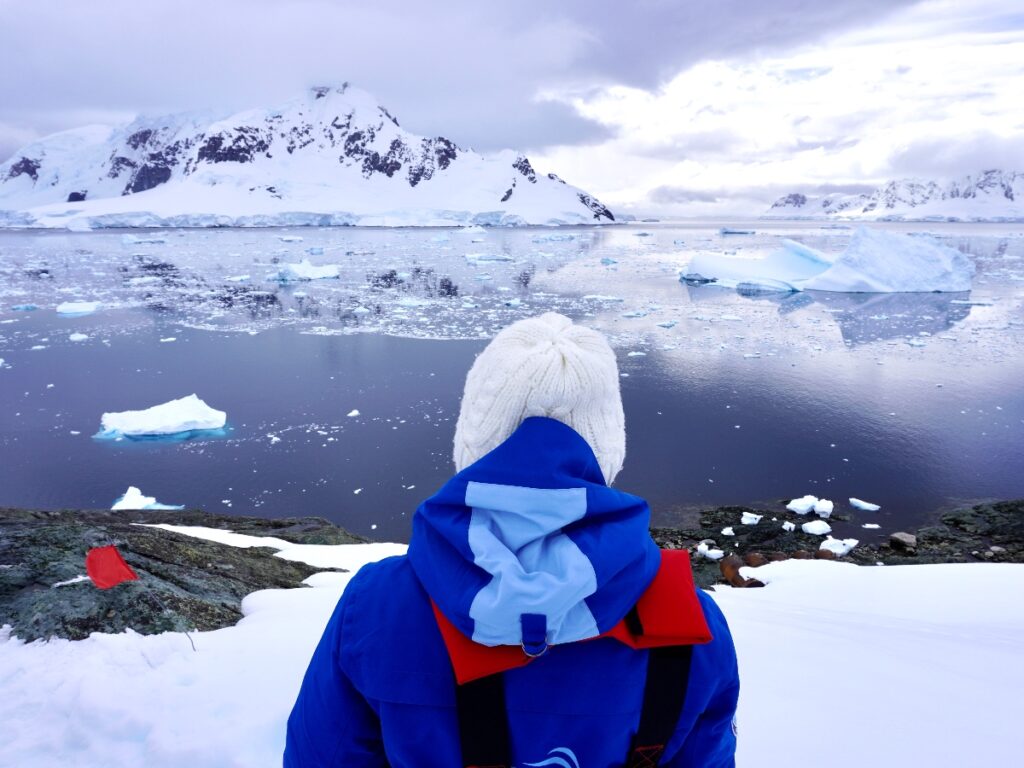
This article explains the difference when it comes to Antarctica vs Arctic.
Comparing these opposites might help you decide which icy wonderland to venture to next or at least answer some questions you might have.
Table of Contents
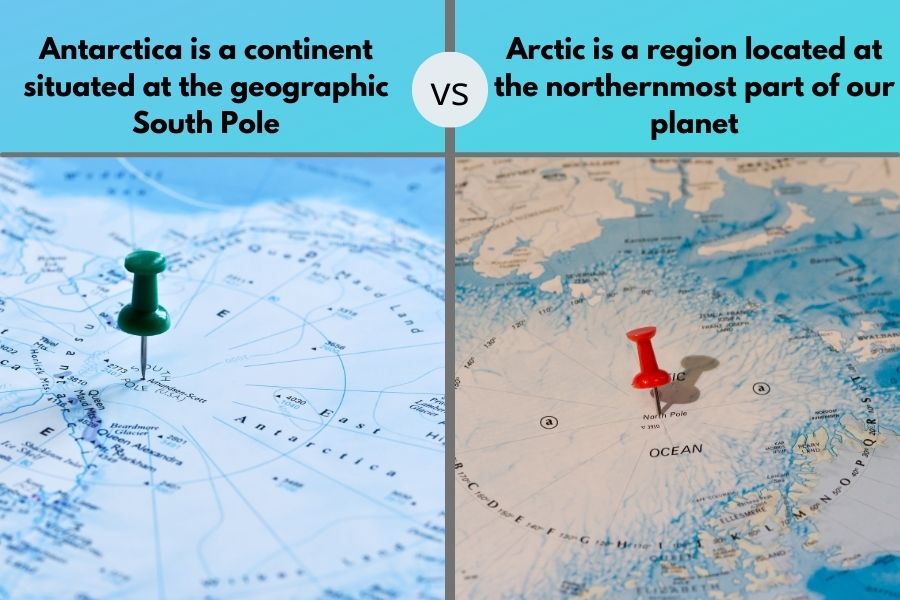
Nestled at the bottom of the world, Antarctica is a vast, icy continent situated at the geographic South Pole. It is entirely surrounded by the Southern Ocean.
It’s a place of extremes, boasting the coldest temperatures on Earth and surreal landscapes of ice and snow. The continent is located almost entirely within the Antarctic Circle.
In contrast, the Arctic is a polar region located in the northernmost part of our planet.
It spans the Arctic Ocean and includes parts of Russia, Canada, Greenland, the United States, Norway, Sweden, Finland, and Iceland.
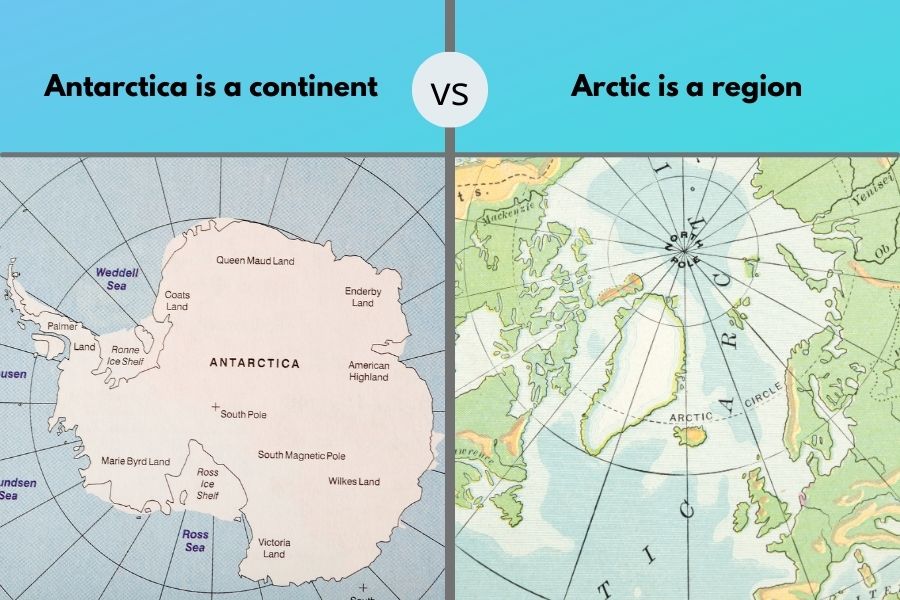
This is one of the key differences when comparing Antarctica vs Arctic. The Arctic is not a continent like Antarctica but a region defined by the Arctic Circle.
On the other hand, Antarctica is a continent, and it might be, for many visitors, the last one out of the seven continents to visit.
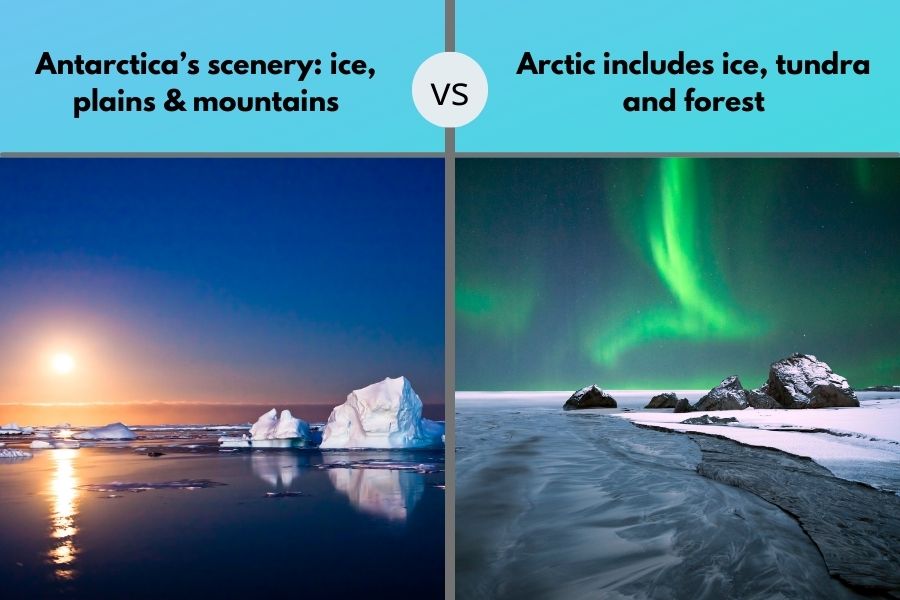
Well, let me simplify this. Regarding landscapes and sceneries, the Arctic is definitely not just snow!
Antarctica’s scenery is a study in contrasts, with towering ice cliffs, expansive ice shelves, and vast, desolate plains of snow. The landscape is dominated by massive glaciers and even the iconic Transantarctic Mountains, creating a pristine and surreal environment.
The Arctic, on the other hand, is characterised by a more dynamic landscape. It features a mix of frozen sea ice, tundra (barren Arctic land), and boreal forests.
Visitors can witness the mesmerising Northern Lights or Midnight sun, explore fjords, and marvel at the rugged beauty of Arctic coastlines.
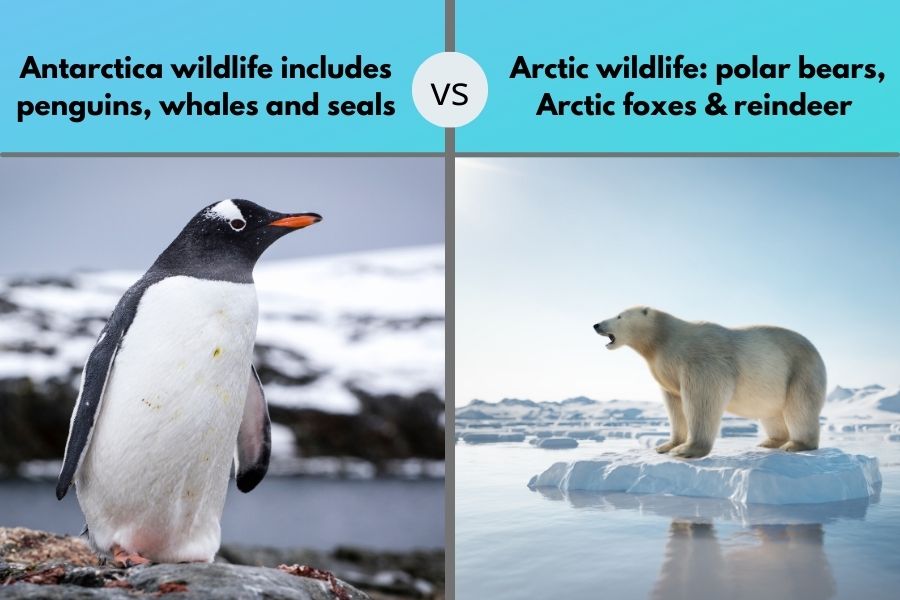
Ok, first of all, there are no polar bears in Antarctica. And there are no penguins in the Arctic. These are important facts when comparing wildlife in Antarctica vs the Arctic.
But let me explain more.
Antarctica is a wildlife enthusiast’s paradise, home to thriving colonies of penguins, seals, and seabirds. The nutrient-rich Southern Ocean surrounding the continent also supports a diverse marine ecosystem, with whales and various species of fish calling these icy waters home.
The Arctic is equally rich in biodiversity, with polar bears, Arctic foxes, reindeer, and various seal species inhabiting the region.
The Arctic Ocean teems with life, including narwhals, beluga whales, and countless seabirds.
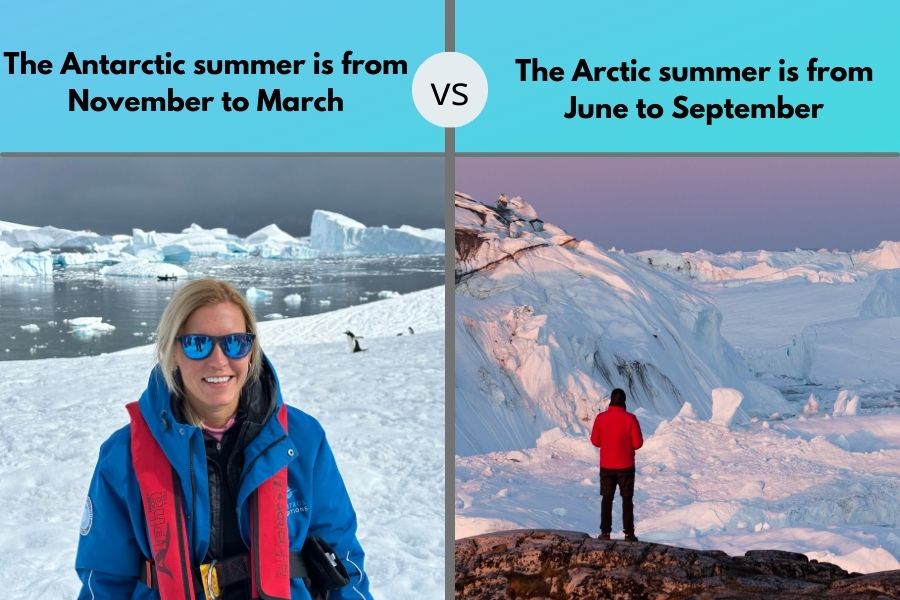
The Antarctic summer, from November to March, offers the best conditions for exploration, with milder temperatures and longer days. This is when wildlife is most active, and the iconic penguin chicks hatch.
And unless you’re a researcher, this is the only time you will visit Antarctica on a commercial cruise.
Read More: 10 Best Tips for Travel in Antarctica
The Arctic experiences distinct seasons, with summer (June to September) being the prime time to visit. During this period, the ice retreats, and wildlife, including polar bears, is active.
The Arctic summer also provides an opportunity to witness the Midnight Sun.
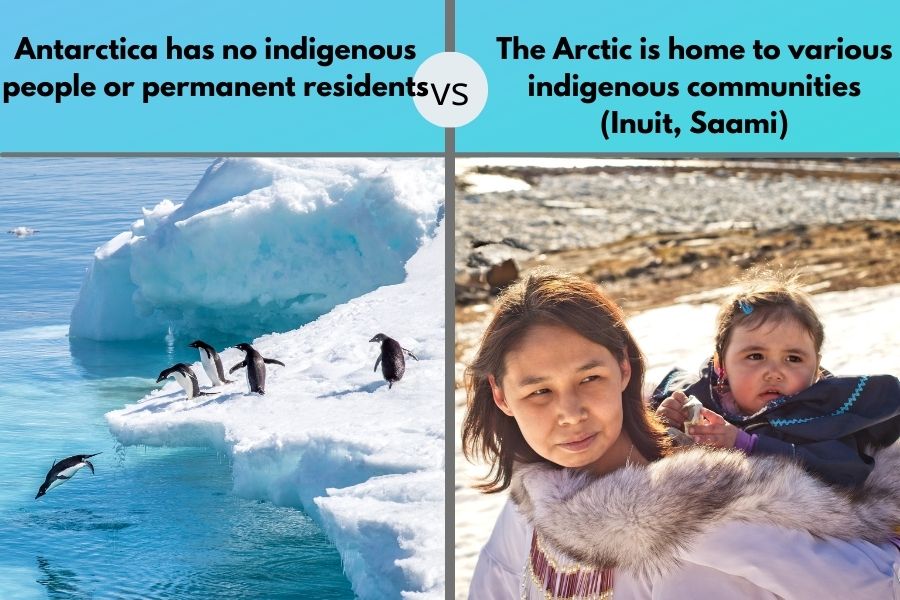
Antarctica has no permanent human residents and is governed by the Antarctic Treaty System, which dedicates the continent to scientific research and prohibits military activity.
While certain countries in the past have claimed parts of Antarctica, according to this treaty, the continent doesn’t belong to anyone.
The Arctic is home to indigenous communities, such as the Inuit, Saami, and Nenets. Each has a very unique culture deeply connected to the Arctic environment.
Respecting and understanding these indigenous communities is crucial when visiting the Arctic region.
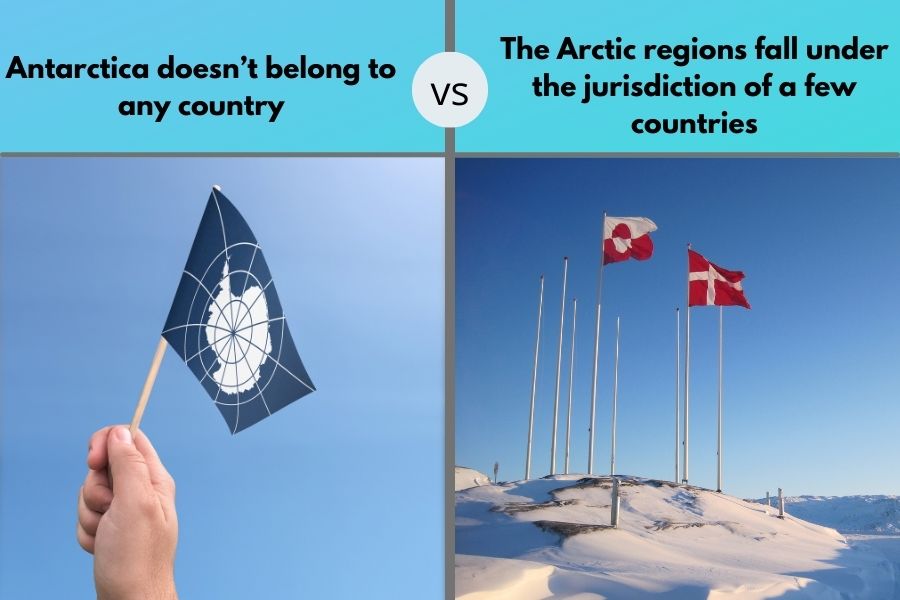
Governance in Antarctica is guided by the Antarctic Treaty System, signed by numerous countries. This international agreement aims to preserve the continent for scientific research and environmental protection. So, in practice, all research teams share information, and Antarctica is not part of any country.
The Arctic, with its diverse regions falling under the jurisdiction of different countries (such as Norway, Russia, Canada and a few more), is governed by national laws and international agreements.
The Arctic Council plays a crucial role in facilitating cooperation among Arctic nations.
When choosing between Antarctica and the Arctic, one must consider the icy landscapes and wildlife and the best time to visit each region.
Whether you’re drawn to Antarctica’s pristine isolation or the Arctic’s dynamic beauty, both polar paradises promise unforgettable adventures, each with its own story to tell. And now you know the few differences between Antarctica and the Arctic.
I visited the Antarctica Peninsula on this 9-night cruise in December 2023, and it was an unforgettable trip!
Our ship for this Polar adventure was fantastic and now I’m inspired to book this 12 Day North Atlantic Expedition to explore the Arctic, travelling on the same vessel.
Want to explore all of your options for trips to the Arctic and Antarctica? Choose from these cruises to Antarctica or these Arctic Expeditions with Viva Expeditions. Quote this code: VIPNOMADS to your Polar Specialist when reserving your trip and get an extra 5% discount!
If you enjoyed this post, you may enjoy learning the differences between Slovakia vs Slovenia, or Iran vs Iraq, and the Baltics vs Balkans.
✈️ Flights: We use Skyscanner to book cheap flights worldwide.
🏨 Accommodation: Booking.com is our preferred platform for booking hotels and accommodation.
🏥 Travel Insurance: We recommend Heymondo (Get 5% off Heymondo) & SafetyWing
🚌 Transportation: Trainline is the best website to reserve trains. We use Omio to book transport worldwide. For travel in Asia, we use 12Go.
🚘 Car Rental: We use DiscoverCars to book rental cars worldwide.
👫 Group Tours: G Adventures OR compare multi-day tours worldwide with Tourradar.
📸 Day Tours & Trips: GetYourGuide & Viator are the only two platforms you need.
📚 Lonely Planet: The Best Range of Travel Guides & Ebooks, and FREE Shipping! (use code RACHELDAVEY10 for a 10% discount)
🎒 Luggage: Osprey Farpoint 40L Backpack or Samsonite Luggage Range.
🛄 What to Pack: Don’t forget your Universal charger and a good power bank. To help you pack the essentials, here is our ULTIMATE Packing List for all Travellers.
🐶 Become a House Sitter: Join Trusted Housesitters and enjoy FREE accommodation worldwide. Use our invite to receive 25% off your new membership.
💰 Send Money Anywhere: WISE & Revolut are the best online accounts that let you send money, get paid, and spend money internationally. Both are so easy to use and way cheaper than any bank transfer.
📶 Stay Connected: Airalo eSIM allows you to get connected the moment you land at your destination, and you can avoid those expensive data roaming charges. We LOVE this product! Use promo code NOMAD15 for 15% off ALL eSIMs (new Airalo users only) OR use NOMAD10 for 10% off ALL eSIMs (for existing Airalo users)
✅ Check out our Travel Gear and Travel Resources for more valuable tips to save you money!